The IFT Plenary approves the variables that will apply to the mobile interconnection cost model for the period of 2012 - 2014 (Press Release 11/2013)
The IFT Plenary approves the variables that will apply to the mobile interconnection cost model for the period of 2012 – 2014
· The transparency of the resolutions that the Commission issues on mobile interconnection rates is strengthened
· IFT orders the beginning of the review process for the methodology of cost models
· It issues the Institute Transparency Council organizational and operational rules
· IFT designates Commissioner Fernando Borjón as president of the Technical Committee of Portability
· IFT approves modifications to capacity provision services on concession titles for microwave connections, with regards to the possibility of extension.
In extraordinary session, the Federal Telecommunications Institute (Instituto Federal de Telecomunicaciones, IFT) Plenary, unanimously approved the relevant variables that will apply to the Cost Model for Mobile services that will be used to resolve the non-stipulated interconnection conditions between public telecommunication networks concessionaires, pursuant to article 42 of the Federal Telecommunications Law for the 2012-2014 period. This determination will allow to quickly resolve the interconnection disagreements presented by the concessionaires to this regulating body.
The relevant variables of the cost model of mobile interconnection and the obtained results will be effective from January 1st, 2012 to December 31st, 2014. Within the approved variables, by means of Agreement P/IFT/EXT/291113/11, it was determined that the cost model of mobile interconnection will be based on an existing hypothetical operator in the long term, with a 33 percent market quota. This is going to offer certainty and transparency when calculating the rates that concessionaires will apply to interconnect their networks, which will fortify the decisions of this Institute.
On the other hand, it is important to note that this Institute is aware of the international debate that exists regards the accomplishment of interconnection approaches, as well as of the methodologies for cost models. In this respect, the European Community has pronounced the use of sole incremental costs, whereas other international bodies have debated on diverse approaches for interconnection such as El que llama paga (“Calling party pays”), make-whole agreements (Bill & Keep), fees based on the quality of the service and massive invoicing.
Due to the above, the Institute Plenary instructed the Regulatory Policy Unit (UPR) to a review process of the regulatory policy for interconnection issues during the first quarter of 2014. With this process the IFT recognizes the existence of the international debate in which Mexico cannot be isolated.
It is important to note that with this Agreement, continuity is achieved with a suitable regulation, precisely and impartially in interconnection issues, which promotes and facilitates the public telecommunications networks use, which entrance of efficient competitors in the market encourages, and incorporates new technologies and services and generates healthy competition between the participants of the market. The above will be translated in a direct benefit toward the users when granting them the opportunity to acquire more services at a lower price, higher quality and diversity.
IFT agrees to issue rules for the Transparency Council
Furthermore, the IFT Plenary decided, by means of Agreement P/IFT/EXT/291113/9, to issue the organizational and operational Institute Transparency Council rules, as well as 2 Press Release Number 11/2013 the procedures for the review and reconsideration pursuant to article 61, sections V and VII of the Federal Transparency Law and Access to Governmental Public Information.
This article establishes that the independent constitutional bodies, such is the Institute case, must have a procedure to the effect in which any person can promote a review or reconsideration recourse under the terms according to the law.
Pursuant to the IFT Organic Statute, the Plenary designated Commissioner Adriana Labardini as Transparency Council president, which will be in charge of resolving the recourses of review and reconsideration, as the case may be, the incidents of resolution breaches that occur, will promote transparency and access to information in the Institute and will require information from the responsible areas that allows the fulfillment of its functions.
The Transparency Council is authorized to issue recommendations on the policies of the Institute and programs in the matters of transparency and access to information.
IFT designates Commissioner Fernando Borjón to preside over the Technical Committee of Portability
On another note, during the past ordinary session, IFT Plenary designated Commissioner Luis Fernando Borjón Figueroa, by means of Agreement P/IFT/271113/21, to preside and coordinate the Technical Committee of Portability, as well as the Head of the Industry Services Unit, Rafael Eslava Herrada, as deputy for the President of this Committee. In addition, it named General Director of Telecommunications and International Subjects, Ante Salcedo González, as secretary to this Committee, and the General Director of Supervision, Felipe Alfonso Hernández Maya, as deputy. 3 Press Release Number 11/2013 Due to the relevance of the numerical portability scheme for the efficient development of telecommunications, the permanent approach with the suppliers of the service - within the sessions of the Portability Committee - is fundamental to comprehend the problems of the industry, enter into dialogues, promote consensus, and consequently, to make the best regulatory decisions, always in benefit of the user.
IFT approves modification to concession titles
Similarly, in the last ordinary session, the Plenary approved modifications to the eighth condition of provider capacity concession services for the establishment of microwave connections point to point and point to multipoint pertaining to the companies owned by Teléfonos de México, S.A.B de C.V., with Agreement P/IFT/271113/17; Nextel de México, S. de R.L. de C.V., with Agreement P/IFT/271113/18; and Inalam, S.A. de C.V., under Agreement P/IFT/271113/19, in order that these concessions have the possibility of being subject to analysis for the granting of the prorogation of their respective validity by IFT, authority with the exclusive attribution to determine the origin or not of this grant.
The eighth condition of the concession titles of these companies establishes that the assigned frequencies will be auctioned again at least three years before the concessions ongoing ends, which contravenes article 19 of the Federal Telecommunications Law, reason why the approved resolution today contributes to harmonize the rules of the effective normativity.
The Plenary approved for the referred titles of concession it is established that the concession could be extended totally or partially, according to IFT judgment, pursuant to Law and other applicable prescribed and administrative legal dispositions, for which, in its case, it will previously require the payment of a consideration, which amount will be taken into account, among other criteria, the bandwidth of the frequencies under concession, the geographic coverage of the concession and the services that the bands can provide.
With this concession titles of merit modification, IFT grants legal certainty to the concessionaires, which promotes the use of the infrastructure and stimulates the connection of networks for data massive transportation.
Documentos para descargar
Temas relacionados
The telecommunications sector grew 3.4 percent during the fourth quarter of 2013 (Press Release 10/2014)
The telecommunications sector grew 3.4 percent during the fourth quarter of 2013
- The broadband mobile connections increased by 46.6 percent, with respect to the same period in 2012, and came to a total of 16.56 million
- Incoming international long distance registered an increase of 27.6 percent, with respect to the same period in 2012
- Mobile telephony services presented an increase of 393 thousand subscriptions in the quarter, with which the base reached 103.6 million
- The service of restricted television reached a total of 14.7 million subscriptions, impelled mainly by the growth of 15.9 and 11.7 percent in the cable and satellite segments, with respect to the same period in 2012
During the fourth quarter of 2013, the Telecommunications Sector Production Volume Index (Índice de Producción del Sector Telecomunicaciones, ITEL)[1], which measures the behavior of the variations of the main variables of production of the telecommunications sector in the country, registered a growth of 3.4 percent in relation to the same quarter in 2012, figure superior to the growth of the Gross Domestic Product (0.7 percent) and which represents almost five times more than the economy as a whole, with which telecommunications continue to consolidate as one of the sectors that help to the growth of the country.
This way, the sector grew in annual terms to an average rate of 8 percent, in relation to the same period in 2012.

According to ITEL results, the services with better performance in the quarter were: incoming international long distance, registering a growth of 27.6 percent; cable television, with an increase of 15.9 percent; television via satellite, with an increase of 11.7 percent; provision of satellite capacity, with an equal adjustment to the previous quarter of 10.6 percent and mobile cellular telephony, with an advance of 5.6 percent, all measured year-on-year quarterly rates.

In recent years, new technologies offer a great diversity of services, every time more accessible for telecommunications users, replacing the existing services; derivative of this, operators are adopting new strategies to gain more market, also, the users have been specialized more and more in the knowledge and operation of the technologies causing a rising increase in their demand.
Restricted television
The service of restricted television, in its modalities, television via satellite, cable television and television by microwave, grew 13.4 percent during the fourth quarter of 2013, with respect to the same period in 2012.
The service of television via satellite or DTH registered a growth of 11.7 percent in the period, which, although significant, is the lowest registered since the second quarter of 2009. This modality totalized in 7.8 million subscriptions in the last quarter of the year, consolidating itself as the main technology for paid television.
Television by cable observed a greater growth in the quarter, with a rate of 15.9 percent, and concluded the quarter with 6.8 million subscriptions, which represent 46.3 percent of the total of restricted television users.
The number of subscriptions of television via microwave (Multichannel Multipoint Distribution Service, MMDS) services maintains its negative trend, falling by 11.5 percent at an annual rate in the last quarter of 2013 with respect to the same quarter in 2012. At the end of the period, this service had over 134 thousand subscriptions.

Mobile telephony
Mobile telephony service registered an increase of 5.6 percent in traffic minutes within the network during the fourth quarter of 2013. From September to December 2013, 393 thousand subscriptions were added, which represent a 3.9 percent increase with respect to the same period the previous year. The base totals 103.6 million subscriptions and represents 87 subscriptions for each 100 inhabitants.

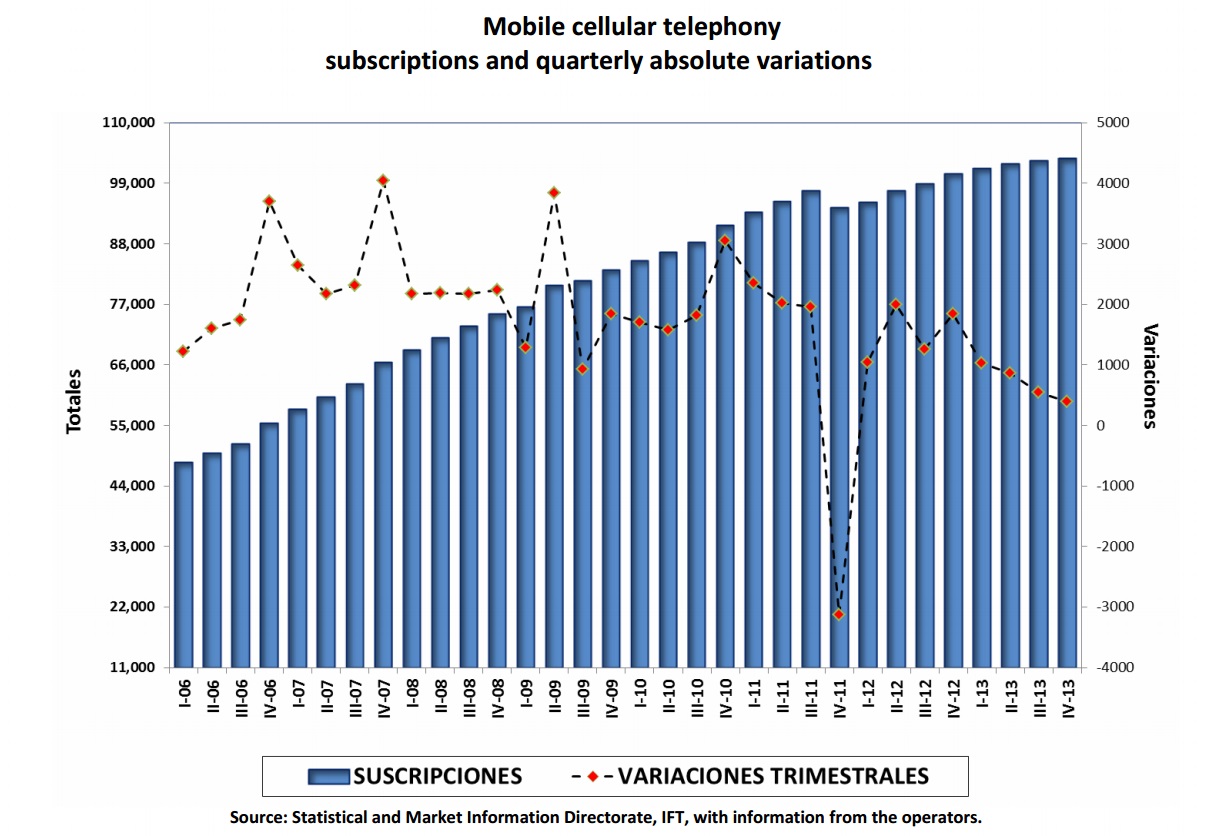
With regard to the composition of the market by type of subscription, at the close of the last quarter of 2013, 16 million post pay users were reported, who represent 15.4 percent of the market total.
Whereas in the prepayment modality, the number closed at 87.6 million subscriptions, which represents a growth of 3 percent with respect to the same period in 2012, and 84.6 percent of the market total.
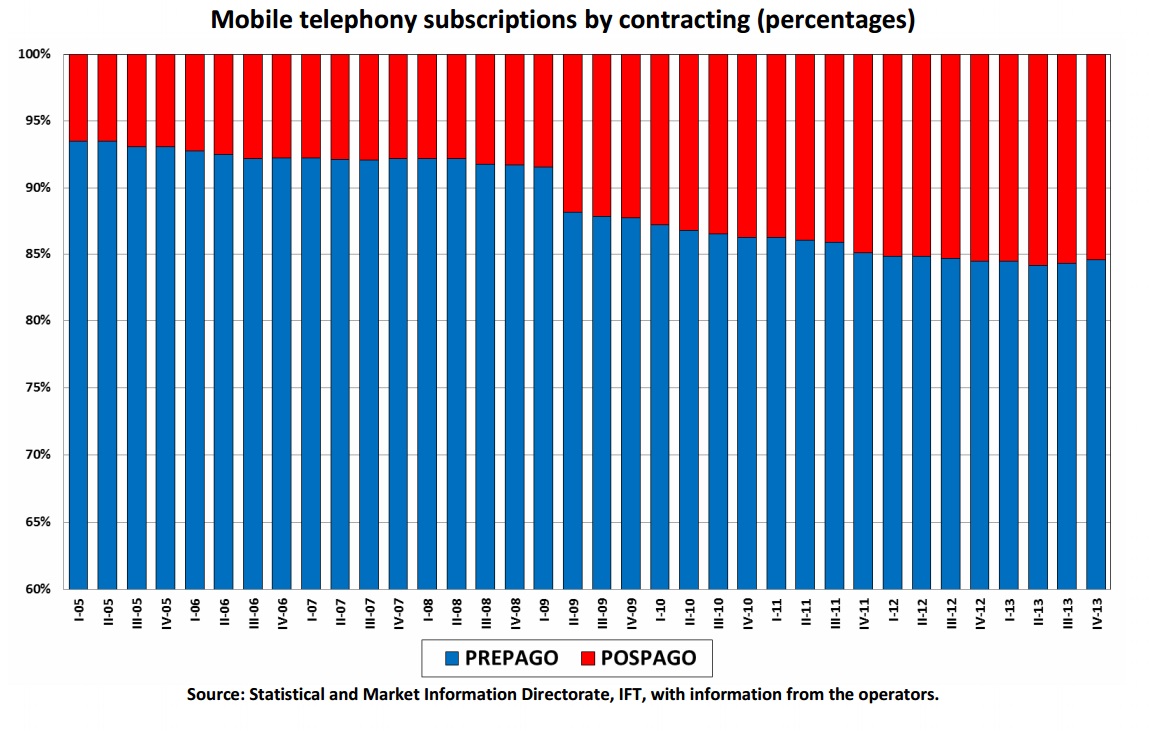
The subscriptions of mobile broadband registered a growth rate of 46.6 percent with respect to the same period in 2012, with which the subscriptions base rose to 16.6 million.
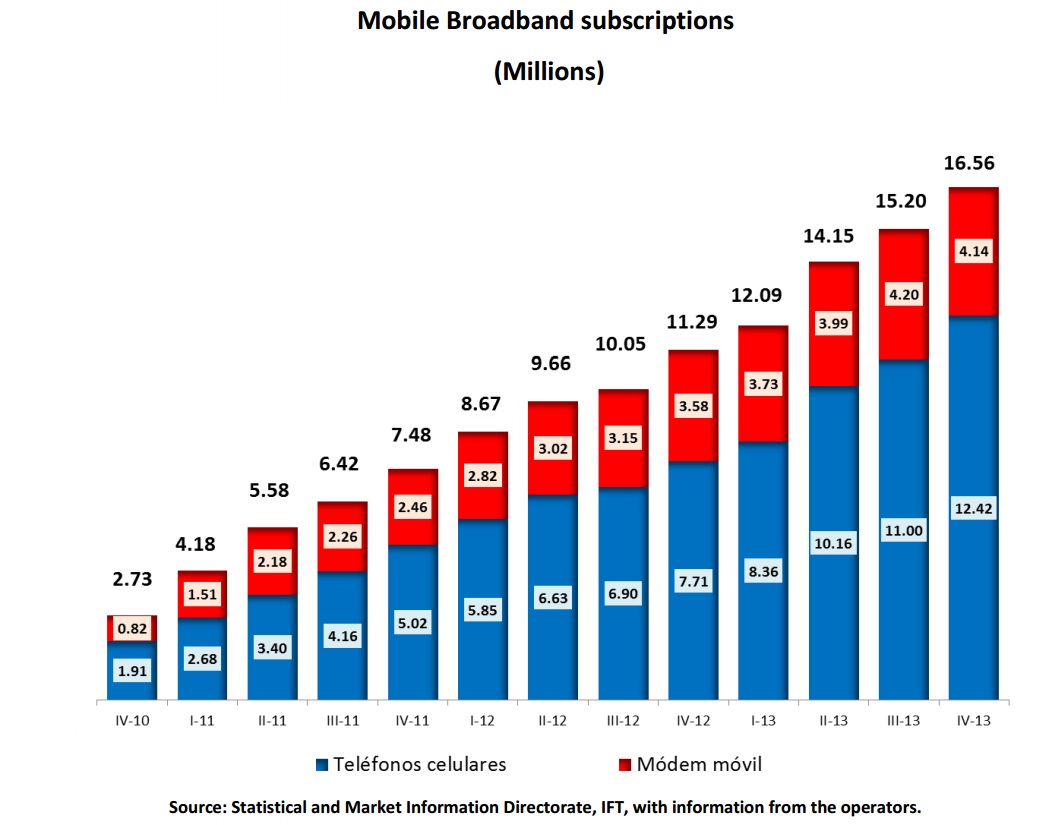
Messages (SMS) sent by mobile cellular telephony networks decreased by 30.6 percent, with respect to the fourth quarter of 2012, which equals an average of 159 messages sent by subscription in the period, the lowest number registered since the second quarter of 2009, with a historical maximum of 252 SMS in the second quarter of 2012.
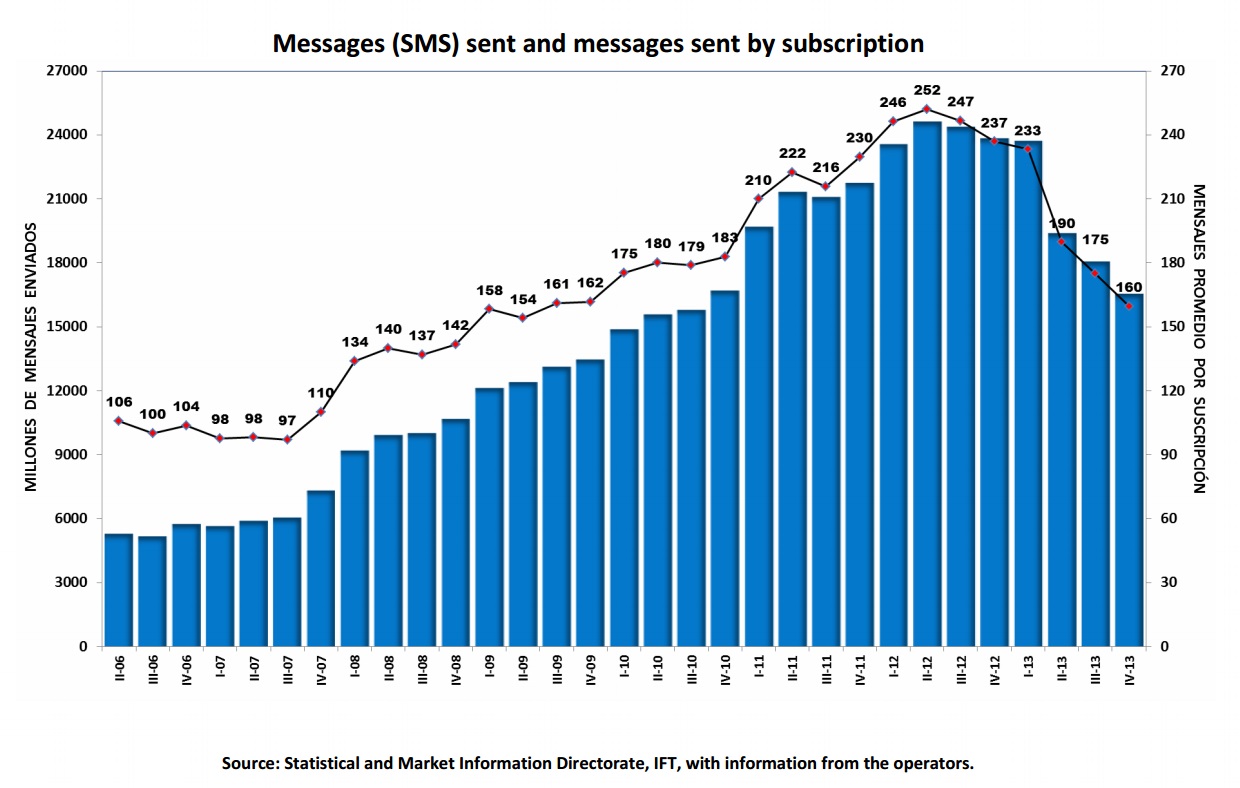
National long distance
During the reported quarter, the traffic measured in minutes grew 10.8 percent in regards to the same quarter of the previous year.
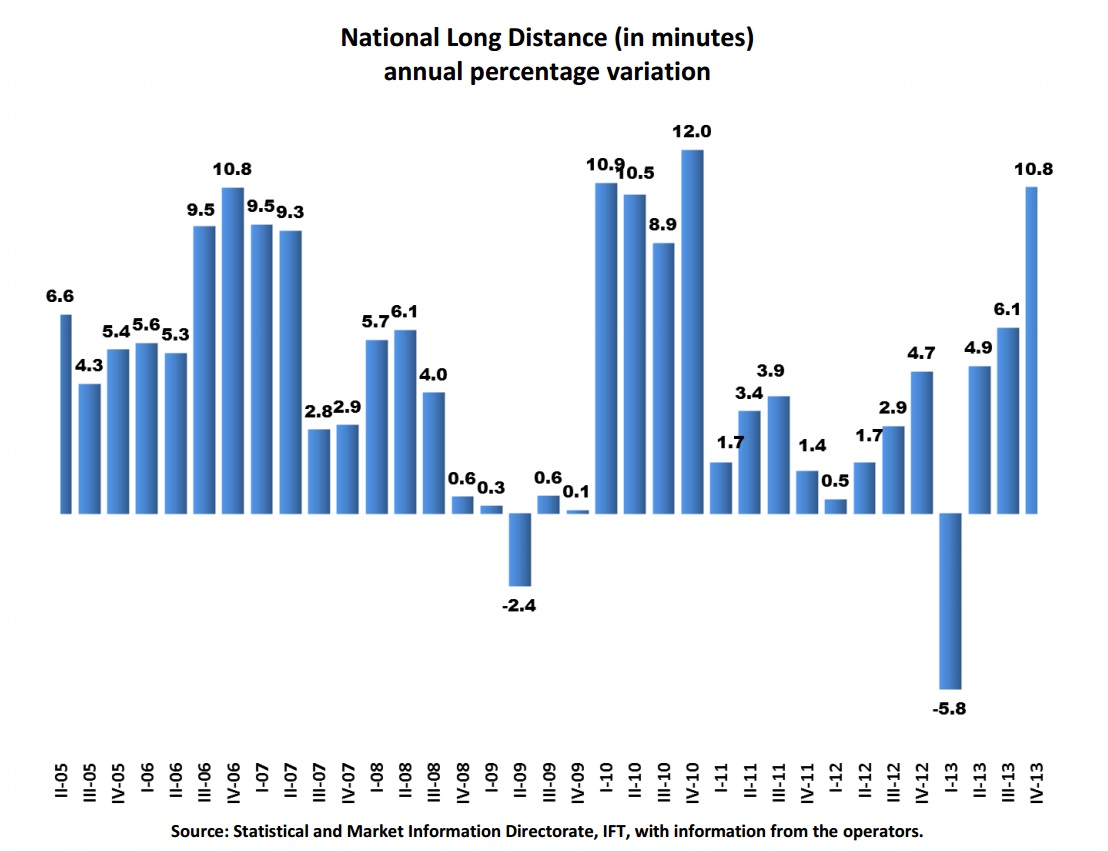
On its part, the average national long distance rate was 0.68 pesos per minute.
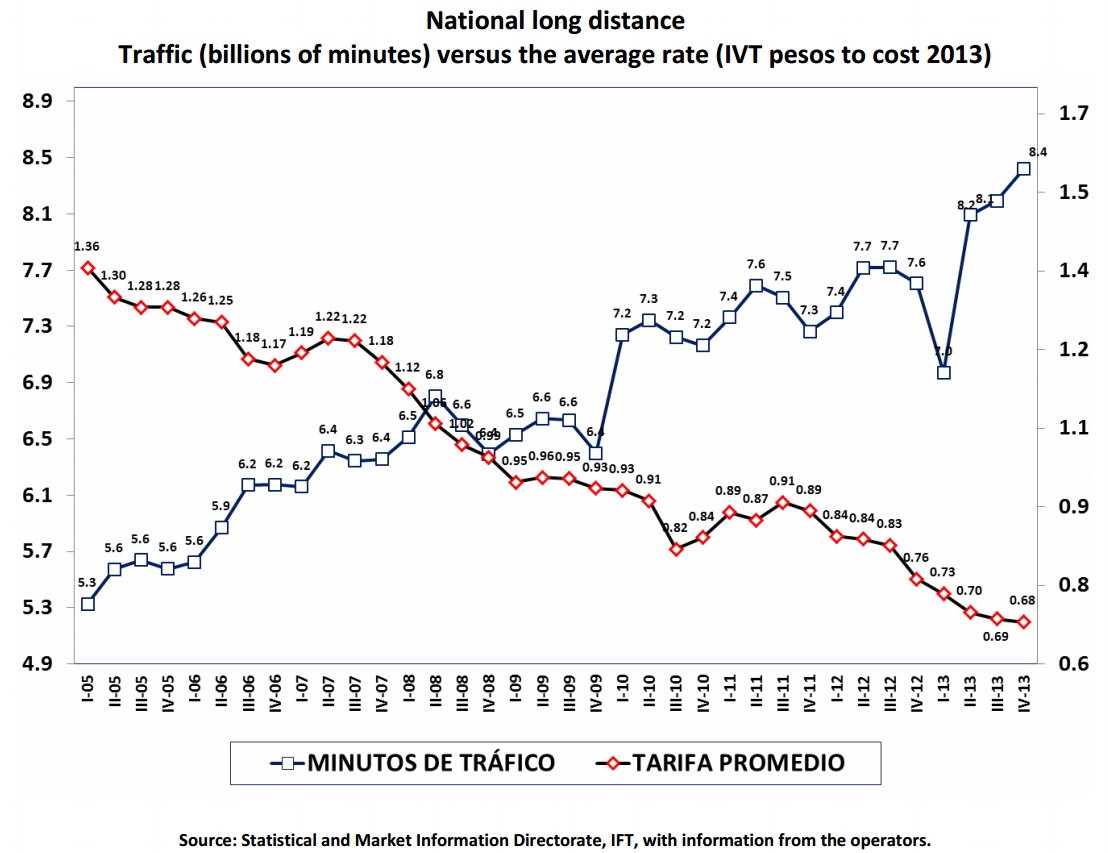
International long distance
During the quarter, the minutes of traffic of incoming international long distance increased by 27.6 percent with respect to the third quarter of 2012, result of the perspective of greater growth of the American economy.

For its part, the minutes of traffic of outgoing international long distance experienced a growth of 3.5 percent in the reported quarter, compared to the same period of the previous year.
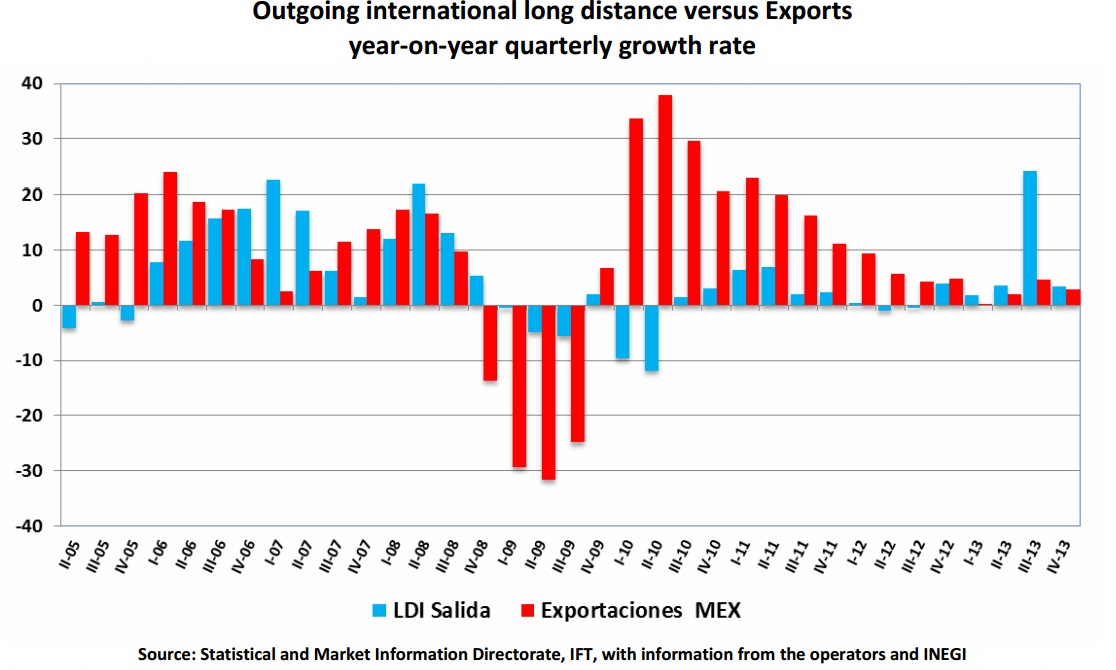
The behavior of international long distance traffic in our country is related to the economic activity of the United States, given the integration of both nations, country with 98.8 percent of the incoming traffic and 88.1 percent of the outgoing traffic.
Trunking
During the last quarter of 2013, the number of users in this segment decreased by 39.8 percent with respect to the same period of 2012, which meant the lowest rate reported from the start of measurement of ITEL.
The users of specialized radio communication services (Trunking) are migrating toward state-of-the-art mobile telephony services, with 2.1 million users at the end of 2013.
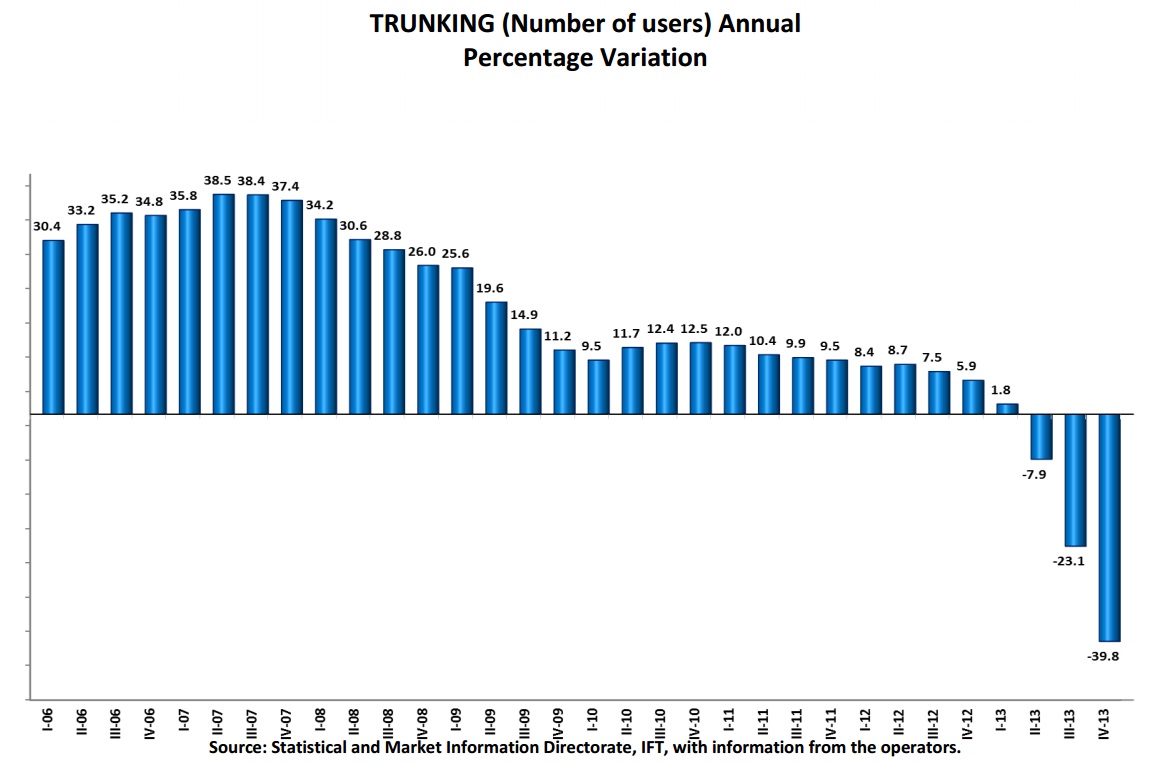
Satellite provision
This segment registered an annual increase of 10.6 percent during the fourth quarter of 2013, equal to the rate reported in the previous quarter. The greater growth of this service can be explained, in part, by the startup of new satellites for public and private services. The unit of measurement for the provision of satellite capacity are Megahertz (MHz).
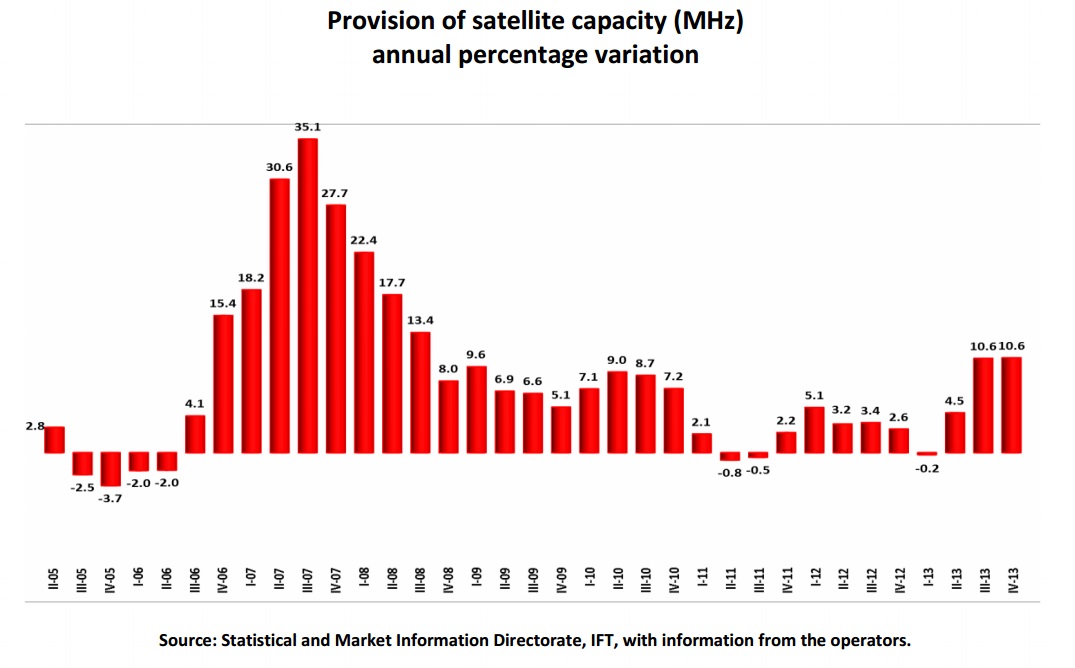
Local fixed telephony
The end of 2013 registered a total number of 20.6 million fixed telephone subscriptions, which represent 490 thousand lines above the same quarter in 2012, and corresponds to a yearly increase of 1.9 percent quarterly in that period. The tendency of this service to rise comes from the alternative suppliers of fixed telephony and from the cable television operators who incorporate the telephony service to their commercial offers. With these modifications in the fixed telephony market, the density of this service in Mexico in the fourth quarter of 2013 was 17.3 fixed telephone subscriptions for each 100 inhabitants.
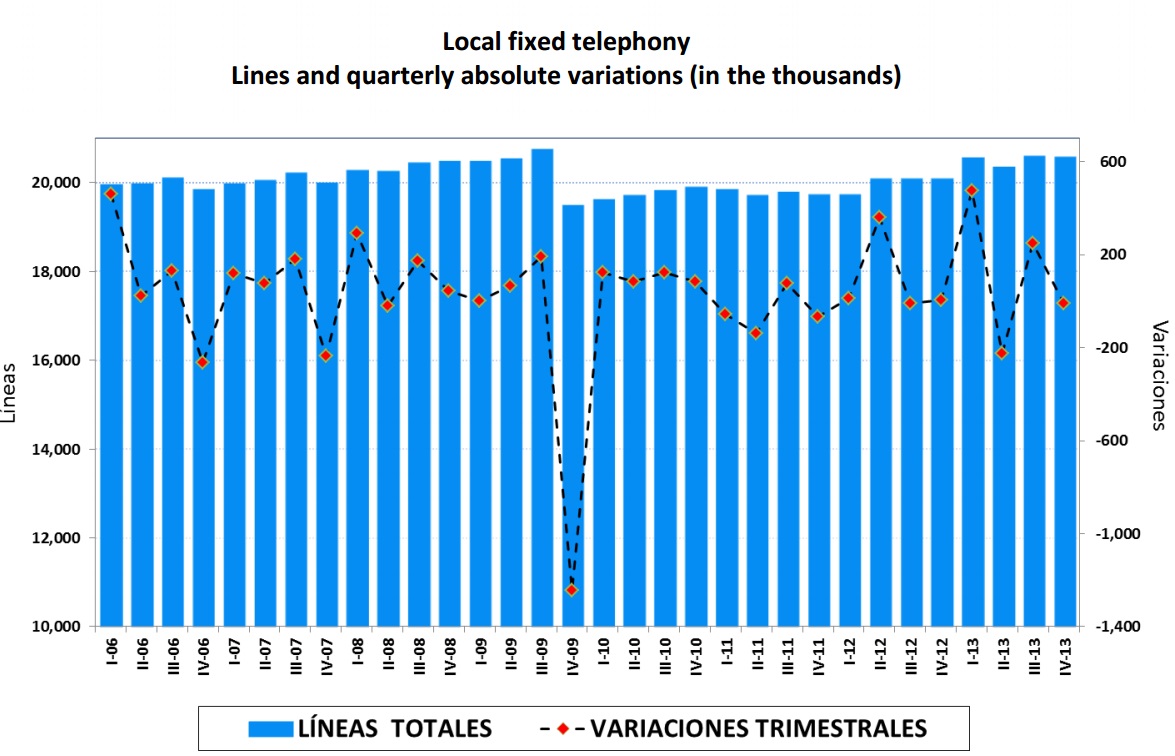

Paging
With regards to the Paging market, the number of users continues with a decreasing tendency; during the last quarter of 2013, the number of users decreased by 33 percent, with respect to the same period in 2012, with 2 thousand 200 users.
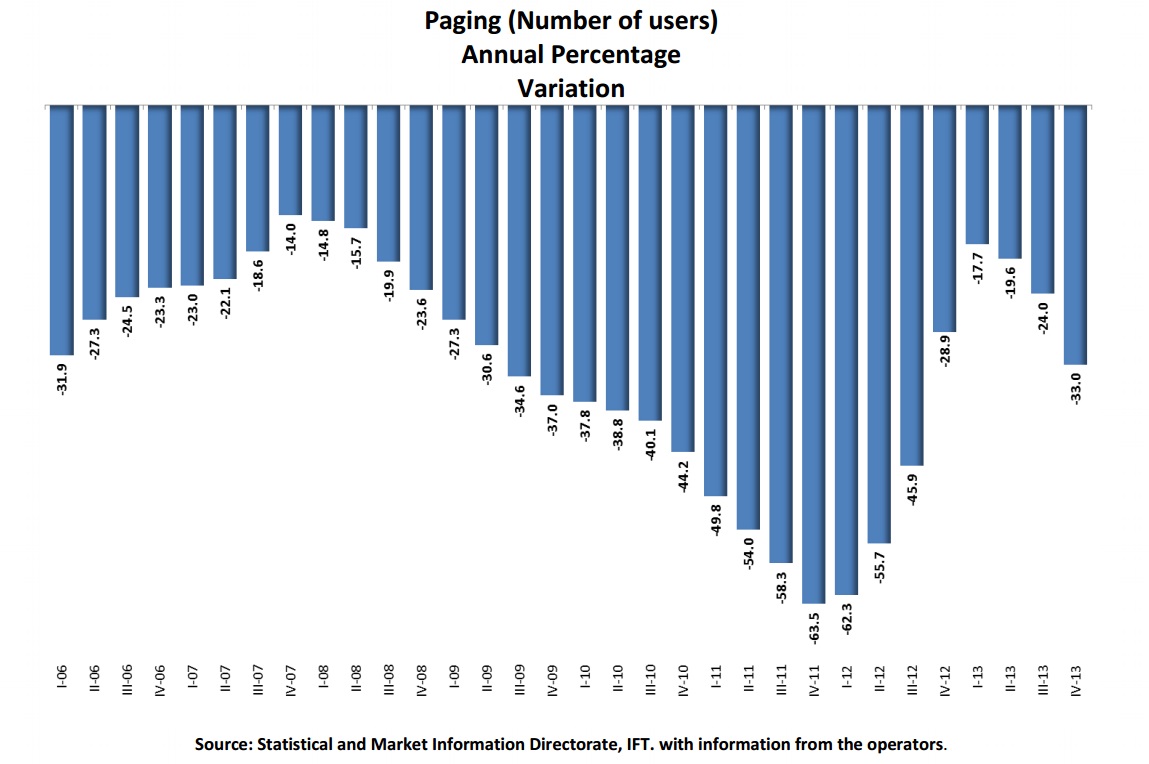
Evolution of rates
The expansion of Internet services, the access to technology at better costs and the competition in the telecommunications market have generated that the concessionaires offer packages and promotions with more attractive rates every time, reason why these present a tendency to lower in nominal and real terms, which has allowed that more and more inhabitants of the country have access to these service
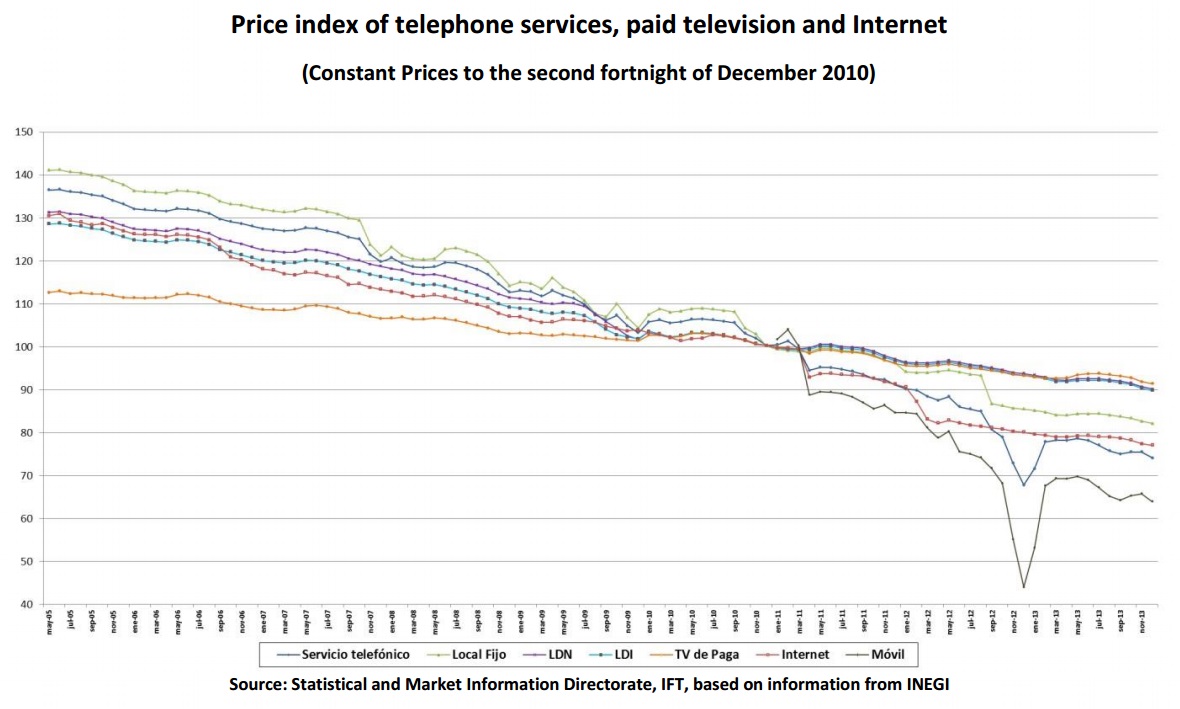
According to information from the National Institute of Informatics, Statistics and Geography (Instituto Nacional de Estadística y Geografía, INEGI), the prices of telecommunications services, measured based on subscripts that compose the National Index of Consumer Prices (Índice Nacional de Precios al Consumidor, INPC), showed important reductions during the fourth quarter of 2013.
This period showed a reduction of the subscript of prices of the telephone service in the order of 9.3 percent, in relation to the same period of 2012, which is composed of a decrease of 4 percent in the local fixed service, reductions of 3.8 percent both in the national long distance service and international long distance service, and contrary in this period, mobile telephony grew 45.1 percent.
As part of the subscript of other services calculated by the INEGI, reductions in real terms of 2.1 and 3.8 percent in the services of paid television and Internet are observed, respectively, compared to the same period in 2012.
It is important to mention that the measurements of telecommunications services prices made by the INEGI are within the objectives of the INPC, that is to measure the evolution in time of the general level of prices of the goods and services that urban homes of the country consume; in this sense, its representativeness is focused on a basket of goods and services that reflect the consumption patterns in homes2[2].
Final considerations
During the trimester of reference, it is observed that the tendency continues toward a moderate growth of fixed voice telephony services; which has been compensated mainly by the advance in the subscriptions of the broadband services that the fixed telephony companies can provide on their same telecommunications infrastructure.
The service of continuous mobile broadband, being one of the pillars of the growth of the telecommunications sector, growing at two digit rates in subscriptions, stimulated to a great extent by the reductions of rates and the development of applications for state-of-the-art mobile devices.
The restricted television market acquired a new dynamic from which the competition between operators and the new consumption patterns of the users who demand an ampler range of rate plans, accessibility and lower prices.
It is expected that during the following quarters, the tendency of growth of this industry is maintained, supported, partly, by the expectation of growth of the Mexican economy, from 3,4 percent for this year to 3.9 percent for 2015, and the expectations regarding the American economy, which expects a growth of 2.73 and 2.99 percent for 2014 and 2015, respectively.[3]
NOTE: The results in the present document come from data and estimations to the year 2013.
[1] An explanation of the methodology used for the calculation of the ITEL can be seen at:
https://www.ift.org.mx/iftweb/wp-content/uploads/2012/09/ITEL_Nota-Metodologica_2010.pdf
[2] A more comprehensive explanation can be found in methodological documents of INEGI, which can be consulted at: http://www.inegi.org.mx/est/contenidos/proyectos/inp/Default.aspx.
[3] Source: Bank of Mexico: Survey on the expectations of the specialists in economy of the private sector: January, 2014.
Documentos para descargar
Temas relacionados
The Federal Telecommunications Institute participates in the MWC 2014 in Barcelona (Press Release 9/2014)
The Federal Telecommunications Institute participates in the MWC 2014 in Barcelona
- Commissioner Adriana Labardini and Commissioner Fernando Borjón attend on behalf of IFT Plenary
- This is the most important international event for mobile telecommunications in the industry
- Commissioners Labardini and Borjón will participate in the Ministerial Program, the most important forum for the most influential public and private leaders of telecommunications at a global level
- Their participation in this event is aligned with the 2014 Annual Work Schedule objectives and responds to one of the high-priority projects; which is to position the Institute on the international scope
The Mobile World Congress (MWC) will be held from February 23th to 27th of 2014. This is the most important event for the mobile industry at a global level, as it is considered a catalyst for change and innovation. A working group from the Federal Telecommunications Institute (Instituto Federal de Telecomunicaciones, IFT) will attend, headed by commissioners Adriana Labardini and Fernando Borjón.
IFT commissioners will attend a full agenda that includes presentations, bilateral meetings with regulating bodies and ministries of communications representatives of high-priority countries for the discussion of better practices in regulatory matters, directly related to the decision making process of the Institute in the short and medium term.
Specifically, the Ministerial Program is of special note, forum which the most influential leaders of telecommunications in the world will attend to interchange points of view about the subjects of greater relevance that will affect the future of the mobile industry, as well as to explore new paradigms in public policies to manage networks and to facilitate investments.
State ministries and regulating authorities are invited to this forum, as well as leading representatives of international organizations and selected intergovernmental organizations, executives and directives of industry regulation for mobile telecommunications, including network operators, and suppliers.
The topics are the opportunities and challenges for the mobile industry in all markets, specific questions of regulation that give form to the mobile revolution will be examined and thematic workshops will be carried out where the interactive form will be discussed, aspects that can help governments take advantage of mobile technology for the development and economic growth of their respective countries.
Within the program that the Mexican delegation will carry out, the objective is to generate cooperation means with the regulators of different countries as well as areas of common influence in strategic subjects of the international agenda in the matter of mobile communications, to successfully obtain information and specialized knowledge for decision making in related subjects to their administration and efficient use of the radio spectrum, as well as to carry out investigation of norms or standards of equipment and systems, for the availability of the telecommunications services technologies and networks, among others.
As part of the agenda, the IFT commissioners, Adriana Labardini and Fernando Borjón will hold a series of bilateral meetings with representatives of countries such as: Germany, Brazil, Colombia, Spain, the United States, India, Israel, Russia, and directors of companies and organizations worldwide as well.
This Tuesday, February 25th, the Federal Telecommunications Institute delegation held a bilateral meeting with the United States of America Federal Communications Commission (FCC) president Tom Wheeler, and Daniel Sepúlveda, Ambassador for Information Policy issues and International Communications of the Department of State. During this meeting the delegates dialogued on the importance of the Constitutional Reform for Telecommunications matters approved in Mexico.
Later, Commissioner Borjón delivered a keynote speech named “Towards an Universal Access of Broadband in Mexico. Government and industry roles for affordable mobile broadband”, in which he presented the context in the Constitutional Reform, the IFT impact, and the plans and the objective consequences of Long Term Evolution (LTE) network in Mexico, particularly according to the accomplishment of an affordable mobile broadband for all country citizens.
This world congress was attended by the Mexican work group IFT general directors: Elizabeth Peña, Roberto Martínez and José Rojas, with the responsibility to follow up on the subjects derived from the bilateral meetings that the Commissioners held for the relevant technical units.
Today, they held bilateral meetings with government representatives of Israel, Spain and Brazil governments, and a working meeting with GSMA directors, to speak of viable public policies that promote the efficient development of the telecommunications sector.
Also, Commissioner Fernando Borjón participated in the Latin American Summit, which was attended by mobile telephony companies directors, as well as high level representatives of the region, to approach subjects such as the role of the government in support of development and long term health of the sector.
This panel discussed the common governments and industry interest for a sustainable mobile sector, as well as the role of the government to assure that mobile services will continue expanding and improving for citizens.
On Wednesday, February 26th, the delegation will visit the MWC expo and later attend to the Ericsson seminar on market and technology global tendencies.
Later, Commissioner Adriana Labardini will participate in a Governmental Round Table, hosted by Alcatel-Lucent, with Ambassador Daniel Sepúlveda participation, the US Department of State, the Rwanda Minister of Communications, the Ivory Coast Minister, the World Bank and the I.A.D.B Secretary General of the African Union of Telecommunications and representatives, to approach the subject “Challenges ahead in a hyper-connected world”.
IFT participation in MWC 2014 agrees with one of the established high-priority projects in the Annual Work Schedule for this year: to position the Institute in the international scope, which derives from one of its main objectives as an effective, impartial and transparent regulator and with better management practices.
The full agenda for the work group can be seen at the following link: https://www.ift.org.mx/iftweb/wp-content/uploads/2014/02/AGENDA-General-P%C3%BAblica.pdf
Documentos para descargar
Temas relacionados
The telecommunication sector grew 6.8 percent during the 2013 fourth quarter (Press Release 9/2013)
The telecommunication sector grew 6.8 percent during the 2013 fourth quarter
- The connections to mobile broadband increased 51.2 percent and reached 15.2 million
- Mobile telephony prices were reduced by 10.4 percent
- Mobile telephony increased by 551,275 subscriptions during the second quarter
- Restricted television service reached a total of 14.6 million subscriptions, impelled mainly by the growth of 17.8 and 13.9 percent in the cable and satellite segments
- Outgoing international long distance registered an increase of 24.1 percent
During the third quarter of 2013, the Telecommunications Sector Production Volume Index, ITEL, (Diágnosticos e Índices de Producción del Sector Telecomunicaciones1), which measures the behavior of the variations of the main variables of production of the telecommunications sector in the country, registered a growth of 6.8 percent in relation to the same quarter in 2012, figure superior to the growth of the Gross Domestic Product (GDP): 1.3 percent. It represents five times more than the economy as a whole, with which telecommunications continue to consolidate as one of the sectors that help the growth of the country.
Although it continues to decelerate in growth, with a smaller rate than the previous quarters of the present year, the growth average of the ITEL from January to September, 2013 was of 9.6 percent.
According to ITEL results, the services with better performance in the quarter were: outgoing international long distance, registering a growth of 24.1 percent; cable television, with an increase of 17.8 percent; television via satellite, with an increase of 13.9 percent; provision of satellite capacity, with an adjustment of 10.6 percent and mobile cellular telephony, with an advance of 9.5 percent, all measured in inter annual quarterly rates.

The growth of the sector in recent years has been impelled by a telecommunications market reconfiguration, which has lead to diverse forms of competition and strategic alliances between the main service providers. The continuous technological changes have made possible new and innovating forms of communication in which services of broadband and data transmission had become the main conductor toward growth through fixed or mobile accesses, as well as the increasing adoption of paid television in Mexican homes.
Due to this, users consumption patterns have been modified: the services of fixed telephony are yielding in importance to the services of mobile telephony, and data services are becoming more important than voice services.
Restricted television
Restricted television market acquired a new dynamic resulting from the competition between operators. This has taken them to offer their clients an ampler range of plans and rates, accessible to a greater number of people with smaller incomes. Adding the segments of television via satellite, cable television and microwave television in the quarter of July-September, there is a growth of 15.4 percent with respect to the same period in 2012.
Television via satellite or DTH presented a growth in the third quarter of 2013, with a rate of 13.9 percent, which although significant, is the lowest registered from the second quarter of 2009. This segment totalized 7.5 million subscriptions at the end of the third quarter of 2013, and continues to consolidate as the main access technology of the Mexican market for paid television.
Television by cable observed a greater growth in the quarter, with a rate of 17.8 percent, and concluded the quarter with 6.9 million subscriptions. These represent 47.3 percent of the total of the subscriptions of restricted television.
The number of subscriptions of television via microwave (MMDS) services maintains its negative trend, falling by 17.6 percent at an annual rate in the third quarter of 2013 with regards to the same quarter in 2012. At the end of the period, this service had 140 thousand subscriptions; this data continues to confirm the migration of clients to cable and satellite television services, which offer greater content.
The previous is consistent with the results presented by restricted television companies with stock in the Mexican Stock Exchange. Megacable reports an increase in its subscriptions of 6 percent with respect to the third quarter of 2012, whereas Cablevisión observed an increase of 9.5 percent in the same period. Cable television companies have supported the positive growth tendency in double and triple-play offers.
For its part, SKY, which provides its services through satellite technology, reported that the number of active net subscribers increased by 232,671 on September 30th, 2013, in comparison with the same period in 2012.
Mobile telephony
Mobile telephony service registered an increase of 9.5 percent in traffic minutes within the network during the reported quarter. From June to September, 2013; 551,275 subscriptions were added, which represent a 4.3 percent increase with regards to the same period the previous year. The base totals 103.1 million subscriptions and represents 86.9 subscriptions for each 100 inhabitants.
Particularly, during the third quarter of 2013, there was an unfavorable effect due to the deceleration of the Mexican economy, in which América Móvil2 reports a slight growth of
0.9 percent income in mobile income and zero growth in minutes by subscription; on its side, Telefónica indicates that it observed a reduction of the income of the mobile service by 2.6 percent, which is partly due to the reduction of prices and a reduction of the Average Revenue Per User (ARPU) by 9.2 percent, as a result of a strong competitive pressure and the reduction of tariffs of interconnection rates3. The dynamics of the mobile telephony sector, in addition to voice traffic, has in the last years rested in the diversification of services, especially in short messages and more recently in the subscriptions to mobile broadband.


With regard to the composition of the market by type of subscription, at the closing of the third quarter of 2013 16.2 million postpay subscriptions were reported, which represent 15.7 percent of the market total, this modality continues to constantly grow. Whereas the number closed in the prepayment modality at 87.0 million subscriptions, which represents a growth of 3.9 percent with regards to the same period in 2012, and 84.3 percent of the total market. As seen in the following graph, the composition of subscriptions has been changing, strengthening the percentage that uses post pay; e.g. América Móvil mentions that closed September with 72.5 million mobile subscribers, 3.0 percent over the number at the beginning of the year, after adding 499 thousand net subscriptions in the quarter, 186 thousand of which were postpay subscribers.

Regarding the data services of mobile operators. The subscriptions of mobile broadband registered a growth rate of 51.2 percent with respect to the same period in 2012, which represents 15.2 million connections.
As indicated, mobile operators have focused their commercial strategies to the diversification of services, including in their mobile Internet services offers; Telefónica reports that the accesses of mobile broadband are the main lever for growth of mobile access and present an inter-annual increase of 36 percent, impelled by the strong growth of “smartphones”, which increase 50 percent inter annually. On its side, América Móvil mentions that mobile data continues to be one of the most dynamic lines of business.

The messages sent (SMS) by mobile cellular telephony networks decreased by 25.9 percent, with regards to the third quarter of 2012, which equals an average of 175 messages sent by subscription in the period, the lowest number registered since the fourth quarter of 2009, with a historical maximum of 252 SMS in the second quarter of 2012.
The spiraling adoption of mobile access devices, especially smartphones and tablets, has favored a growth of the demand of mobile data and the options have been multiplied where the developers can place their applications. The following graph shows that the SMS service continues to decrease, due to a substitution process for other options provided on the broadband Internet service.

National long distance
During the reported quarter, the traffic measured in minutes grew 6.1 percent in regards to the same quarter the previous year. This registers the largest growth rate since the fourth quarter of 2010. On its side, the average long distance rate was 0.69 pesos per minute, i.e., 13.7 percent less than the data observed in the same quarter of 2012.


During the quarter, the traffic minutes of incoming international long distance increased by 2.2 percent with regards to the third quarter of 2012. Annual quarterly growth is the lowest since the fourth quarter of 2009.

For its part, the minutes of outgoing international long distance traffic experienced a growth of 24.1 percent in the reported quarter, compared to the same period of the previous year. The highest observed since the 2000 third quarter.
The previous graph shows that the growth of international long distance during the last quarter goes hand in hand with the level of the remittances and is less than the total imports.

The behavior of international long distance traffic in our country is related to the economic activity of the United States, given the integration of both nations, country with 98 percent of the incoming traffic and 86.1 percent of the outgoing traffic.
Trunking
During the third quarter of 2013, the number of users in this segment decreased by 23.1 percent with regards to the same period in 2012, which meant the lowest rate reported from the ITEL start of development.
The users of specialized radio communication services (Trunking) are migrating toward state-of-the-art mobile telephony services, with 2.8 million users in September of 2013.

Satellite provision
This segment, measured in Megahertz, registered an increase of 10.6 percent during the third quarter of 2013, being the greatest growth from the third quarter of 2008. The increase in the growth of this service can be explained, partly, by the start-up of new satellites for public and private services, which positively affects the demand of this service, since the supply for the companies that contract the service of satellite capacity provision is increased.

Local fixed telephony
The third quarter of 2013 registered a total number of 20.6 million fixed telephone subscriptions, which represent 505 thousand lines above the same quarter in 2012, and corresponds to a yearly increase of 2.4 percent quarterly in that period. As reported, the tendency of this service to rise comes from the fixed telephony alternative suppliers and from the cable television operators who incorporate the telephony service to their commercial offers. In this sense, América Móvil reports a decrease of 1.1 percent in the amount of fixed lines in relation to December of 2012; whereas Maxcom reports that related to the third quarter of 2012 their voice clients have grown 3.0 percent, and Cablevisión registers an increase of 29.5 percent in its telephony users.
With these modifications in the fixed telephony market, the density of this service in Mexico in the third quarter of 2013 was 17.4 fixed telephone subscriptions for each 100 inhabitants.
In fixed local telephony segment we observe a tendency toward smaller growth rates in the amount of lines, as well as two tendencies. On the one hand, a disposition in the market exists towards a decreasing use in homes of the use of fixed voice lines, as a result of a greater preference for mobile telephony services; on the other hand, one of the strategies followed by the fixed local telephone operators is to maintain the generation of income with package services. In this sense, it is possible to obtain within the commercial offers that fixed telephony suppliers provide, services of local telephony, long distance, Internet, television and, in some cases, mobile telephony in a same monthly rent.
Particularly broadband Internet supply is consolidating like one of the main sources of income of the operators and a mechanism to retain clients; in this sense even though América Móvil reports a reduction in its fixed voice lines, it indicates that fixed broadband accesses were increased by 401 thousand in the annual comparative; on the other hand, Axtel reports a growth of 20 percent on its broadband subscribers; and Maxcom indicates that it had an increase of 21 percent on its data clients.


Paging
With regards to the Paging market, the number of users continues decreasing as a consequence of alternatives to communication, such as cellular telephony. In the third quarter of 2013, the number of users decreased by 24.0 percent, with respect to the same period of 2012, closing with 2,733 users.

Evolution of rates
The expansion of broadband services, the introduction of technologies and the application of more attractive promotions have resulted in a general and constant decrease of rates during the past few years.
The competition in the telecommunications market has generated that the concessionaires offer packages and promotions with attractive rates, reason why these present a tendency to decrease in nominal and real terms, which has allowed that more and more inhabitants of the country have access to these services.

According to the National Institute of Informatics, Statistics and Geography (INEGI) information from the prices of telecommunications services, showed important reductions during the third quarter of 2013; measured based on subscripts that compose the National Index of Consumer Prices (INPC).
In September of this year, a reduction of the subscript of prices of the telephone service of 7.1 percent order was observed, in relation to September of 2012, which is made up of a decrease of 3.4 percent in the fixed local service, reductions of 3.3 percent both in the national and international long distance services and a decrease of 10.4 percent in the service of mobile telephony.
As part of the subscript of other spreading services calculated by the INEGI, reductions in real terms of 1.4 and 3.0 percent in the services of paid television and Internet are observed, respectively, compared to the same period in 2012.
It is important to mention that the measurements of telecommunications services prices made by the INEGI are within the objectives of the INPC (in spanish for Indice Nacional de Precios al Consumidor), to measure the evolution in time of the goods and services general level of prices that urban homes of the country consume; in this sense, its representativeness is focused on a basket of goods and services that reflect the consumption patterns in homes4.
Final considerations
The mobile broadband segment has been constituted as the main generator of the continuous growth of mobile telephony operators, growing to two digit rates for total subscriptions, derivative of a greater consumption of data by user stimulated to a great extent by reductions in the prices and the new mobile devices; also the companies in this segment continue to diversify their income generation strategies by means of a greater integration to their offers for mobile Internet services.
However, during the trimester of reference, it is observed that the tendency continues toward a moderate growth of fixed voice telephony services, observing a reduction in the lines of some operators; this tendency has been compensated mainly by the advance in the subscriptions of the broadband services that the fixed telephony companies can provide on their same telecommunications infrastructure.
It is expected that during the following quarters, the tendency of growth of this industry is maintained, supported, partly, by the expectation of growth of the Mexican economy, from 1.2 percent for this year to 3.4 percent for 2014, and the expectations regarding the American economy, which expects growth of 1.69 and 2.55 percent for 2013 and 2014, respectively5.
1 An explanation of the methodology used to calculate ITEL can be consulted at: http://www.cofetel.gob.mx/es_mx/Cofetel_2008/Cofe_metodologia
2 América Móvil, S.A.B. de C.V. Financial and operative report for the third quarter of 2013.
3 Telefónica, Results January-September 2013.
4 A more comprehensive explanation can be found in INEGI's methodologic documents, which can be consulted at http://www.inegi.org.mx/est/contenidos/proyectos/inp/Default.aspx.
5. Source: Bank of Mexico: Survey on the expectations of the specialists in economy of the private sector: October, 2013.
Documentos para descargar
Temas relacionados
The IFT publishes the general guidelines on Must Offer & Must Carry (Press Release 8/2014)
The IFT publishes the general guidelines on Must Offer & Must Carry
- The document is available for consultation at the Institute website and will be published in the Federal Official Gazette during the next few days
- The Agreement approved establishes the technical criteria for the proper application of the obligations provided by the Constitution for retransmitting the signals broadcasted in restricted TV systems
- The concessionaires of restricted TV have the obligation to broadcast free TV signals in the same geographical coverage area without the approval of broadcasted TV concessionaires
The Plenary Agreement of the IFT (Federal Telecommunications Institute) was published today at the Institute website: www.ift.org.mx; which states the “General Guidelines on the provisions of fraction I of the Eighth Transitory Article of the Decree to reform and add several provisions of Articles 6°, 7°, 27, 28, 73, 78, 94 and 105 of the Political Constitution of the Mexican United States on telecommunication matters and will be published in the Federal Official Gazette (Diario Oficial de la Federación, DOF) in the following days.
As informed before, on November 20 of 2013, the IFT submitted to public consultation the general guidelines draft with the purpose of receiving comments, remarks, and proposals about the document contents, which set forth the technical criteria necessary to properly apply the obligations provided for in the Constitution for concessionaires of free and restricted TV about the offer and retransmission of broadcasted signals.
From November 20th to December 19 of 2013, there were 32 public consultations on technical, regulatory, copyright issues, as well as general remarks. On February of 2014, the Radio & TV Systems Unit delivered the results of this consultation for the corresponding analysis of the Plenary.
After being notified about the agreement issued by the Thirty Second Judge of the Civil Court, which states the IFT is not qualified to order free retransmission of certain free TV channels, the Institute requested the Federal Executive Power to issue a constitutional controversy before the National Supreme Court of Justice (Suprema Corte de Justicia de la Nación, SCJN). As a result of this action, the Minister of the SCJN, Olga María del Carmen Sánchez Cordero, accepted to process the controversy suit and granted the suspension of the impugned actions, giving the IFT the opportunity to decide on the matter.
Therefore, during an extraordinary session celebrated on February 21st, the IFT Plenary approved, through Agreement P/EXT/IFT/210214/71, the general Guidelines to retransmit free TV signals in restricted TV systems and to publish the general responses to the remarks, opinions and insights revealed during the public consultation of the aforementioned project.
The purpose of the Guidelines issued is to regulate, within the capabilities of the Institute, the scope of the rights and obligations provided for in the Constitution regarding the retransmission of broadcasted TV signals.
With this Agreement, the Plenary decided that restricted TV concessionaires must retransmit TV signals broadcasted in the same geographical coverage area, regardless of the approval of broadcasted TV concessionaires.
Terrestrial restricted TV concessionaires are forced to retransmit the broadcasted signals of free TV concessionaires only in the same geographical coverage area for free, indiscriminately, integrally, unmodified and simultaneously, including advertisements, and with the same quality of the broadcasted signal; as for the concessionaires of satellite restricted TV, the same obligation applies, except they would only be forced to retransmit free signals that have a national coverage of 50% or more, which are identified with the following commercial names: “Canal de las Estrellas”, “Canal 5”, “Azteca Siete” and “Azteca Trece”.
For satellite restricted TV concessionaires to be able to retransmit the free TV signals covering 50% or more of the national territory in the same geographical coverage area, the Institute website will publish and keep an updated list of the national locations where those signals are broadcasted.
As a result of the public consultation to which the Guidelines Project was submitted and, in response to the feedback received, several modifications were made on the obligation to retransmit the signal only in the same geographical coverage areas where it is transmitted, as well as the obligation to block the signals of live public events, which are not transmitted where they take place, among other modifications.
Likewise, the resolution states free TV and/or restricted TV concessionaires with the necessary authority in any telecommunications or broadcasting market.
In case the satellite restricted TV concessionaires retransmit a broadcasted signal, which is not mandatory, from a certain location, they should retransmit every other free signal in the location.
The Agreement highlights restricted TV concessionaires shall retransmit every broadcasted signal coming from federal public institutions for free, indiscriminately, integrally, unmodified, and simultaneously, including advertisements (if applicable), and with the same quality of the free signal, and must also include the multiprogramming broadcasted signals.
The federal public institutions, which up to now transmit broadcasted signals due to their own juridical nature, are: Universidad Nacional Autónoma de México, Instituto Politécnico Nacional, Organismo Promotor de Medios Audiovisuales, and Televisión Metropolitana, S.A. de C.V.
Finally, the Guidelines approved state the IFT Plenary will solve any controversy related to the application of these provisions.
Documentos para descargar
Temas relacionados
The Plenary of the IFT places the general guidelines project for must carry and must offer under public consultation (Press Release 8/2013)
The Plenary of the IFT places the general guidelines project for Must Carry and Must Offer under public consultation
- This exercise makes the project and technical elements that sustain it transparent.
- The public consultation will be available on the Internet website of the IFT from November 20th and will conclude on December 19th, 2013.
- The results will be considered for issuing the guidelines and a document with specifics will be published, derived from adjustments to the project.
- The Plenary unanimously decided to designate Georgina Santiago Gatica as head of the new Economic Competition Unit.
In extraordinary session, the Federal Telecommunications Institute (Instituto Federal de Telecomunicaciones, IFT) Plenary unanimously resolved to place a general guidelines project under public consultation related to the application of the must carry and must offer schemes, for technical criteria conditions for the due application of the obligations provided by the Constitution for open and restricted television concessionaires in the matter of supply and broadcasting of broadcast signals. Must carry consists of the restricted obligation of television suppliers to transmit open television channels. In agreement with the Decree of Constitutional Reform in Telecommunications matters published in the Federal Official Gazette on June 11th 2013, such broadcasting of open signals through payment systems must be free and nondiscriminatory, within the same area of geographic coverage, in complete, simultaneous form and without modifications, including commercials and with the same quality of the original signal. This Decree establishes for the case of restricted via satellite television concessionaires, who will only have to forcefully transmit the broadcast signals of coverage in fifty percent or more of the national territory. Must offer consists of the obligation of open or broadcast television concessionaires to allow the suppliers of restricted television services to broadcast their signal, freely and nondiscriminatory, within the same zone of geographic coverage, in complete, simultaneous form and without modifications, including commercials and with the same quality of the signal that is broadcast. The obligations to freely offer and to relay the broadcast contents will lose their effect simultaneously when conditions of competition in the broadcasting and telecommunications markets exist. In agreement with the resolution emitted in the second extraordinary session of the IFT Plenary, the document “General guidelines pursuant to section I of the Eighth transitory Article of the Decree in which various dispositions of Articles 6, 7, 27, 28, 73, 78, 94 and 105 of the Political Constitution of the United Mexican States, in the matter of telecommunications are reformed and added”. This exercise has the purpose of making transparent before society in general this project and the technical elements that sustain it, as well as that the Institute This exercise is intended to supplementing the project and its supporting technical elements transparent for the public in general, while the Institute receives in writing the comments, concrete opinions and proposals from interested parties on the content of the guidelines with which this independent regulating body will comply with the obligations and guarantee the rights pursuant to section I of transitory Eighth Article of the Decree. The public consultation will be available on the IFT Internet website: www.ift.org.mx from November 20th and will conclude on December 19th of the current year. Interested parties will be able to download the guidelines and send their commentaries, opinions and proposals electronically. IFT will consider the results of the public consultation for the issue of the guidelines and once it emits its resolution, it will publish a document addressing the comments, opinions and concrete proposals received, specifying in its case, which of them were adjustments and specifications to the referred guidelines. Appointment of the Economic Competition Unit head The IFT Plenary unanimously decided to designate Georgina Santiago Gatica as head of the new Economic Competition Unit (Unidad de Competencia Económica, UCE). On December the 1 st, 2013 Santiago Gatica will take on the position in this independent regulating body. This appointment is a result of the selection process the Institute called on October 30th, 2013 for the head of the UCE. Georgina Santiago Gatica has an economics degree in Economy from the Instituto Tecnológico y de Estudios Superiores de Monterrey, and a master in Economic studies at El Colegio de México. She also has 10 years professional experience in the extinct Federal Competition Commission where, among other positions, she held the Main directorate of Regulated Markets and the Main directorate of Investigations of Relative Monopolistic Practices. She currently acts as an adviser in economic competition matters for the Undersecretary's office of Competitiveness and Standardization in the Ministry of Economy.
Documentos para descargar
Temas relacionados
The IFT Plenary resolves to sanction cable television companies for absolute monopolistic practices (Press Release 7/2014)
The IFT Plenary resolves to sanction cable television companies for absolute monopolistic practices
- The monopolistic practice consisted in an agreement between companies to divide between themselves the production, distribution and trading markets of fixed telephony, restricted television and Internet access to final consumers in the state of Mexico
- The companies are ordered to suspend this sanctioned behavior
- Cablevisión, a branch of Televisa, is imposed with a fine of 8 million 733 thousand 746 pesos
- Megacable is imposed with a fine of 33 million 576 thousand 102 pesos
In an extraordinary session, the Federal Institute of Telecommunications (Instituto Federal de Telecomunicaciones, IFT) Plenary, resolved one of the files in process that the Federal Commission on Economic Competition received, which refers to an Official Letter of Probable Responsibility issued by this authority in August 2013 for absolute monopolistic practices in the production, distribution and trading markets of fixed telephony, restricted television and Internet access of final consumers. The companies declared as potentially responsible were Televisa, Cablevisión, TVI and Cablemás, of Grupo Televisa, and Megacable, a Grupo Megacable company.
On finalization of the stage followed in form of judgment and based on the analysis of the information obtained, the IFT Plenary determined that Grupo Televisa and Grupo Megacable, through their affiliates Cablevisión and Megacable, respectively, incur in absolute monopolistic practices, as per section II of article 9 of the Federal Law of Economic Competition, regarding their agreement under their competitor nature to divide, distribute, assign or impose portions or segments of the production, distribution and trading markets of fixed telephony, restricted television and Internet access to final consumers in various municipalities in the state of Mexico.
Due to the above, the IFT resolved, based on articles 35, section IV and 36 of the Federal Law of Economic Competition to impose the following economic sanctions on the abovementioned companies:
- Cablevisión: a fine of 8 million 733 thousand 746 pesos.
- Megacable: a fine of 33 million 576 thousand 102 pesos.
Likewise, IFT resolved to order Grupo Televisa and Grupo Megacable the suspension of the credited monopolistic practices and present a mechanism with terms to guarantee, which must be submitted for the approval of the Institute in a thirty calendar day term of the date in which the notification of the resolution becomes effective, based on articles 2, 9 section III and 35 of the Federal Law of Economic Competition.
If the mechanism is not presented within the fixed terms, the companies will be fined as an enforcement procedure, and IFT will determine the terms and conditions that the concessionaires must meet to suppress the sanctioned monopolistic practice.
As part of the resolution, it was determined that the investigation did not collect sufficient data allowing to accredit the expected practice in section I of article 9 of the Federal Law of Economic Competition, consisting of agreements with the purpose or effect of fixing or manipulating the prices of the services of the investigated market.
Documentos para descargar
Temas relacionados
The Plenary of the IFT resolved to modify the open television frequency bidding bases to create two television networks with nationwide coverage (Press Release 43/2014)
The Plenary of the IFT resolved to modify the open television frequency bidding bases to create two television networks with nationwide coverage
- Modifications to bidding bases are mainly looking forward to adjusting content to provisions provided for in the new Federal Telecommunications and Broadcasting Law
- Preliminary draft through which the Interconnection Electronic System is established is to be submitted for public consultation
- 15 resolutions are issued for which fines are imposed. Loss of assets for the benefit of the nation were declared, derived from the frequency operations without license or permit in broadcasting
- 11 resolutions are issued for which fines are imposed. Loss of assets in the interest of the nation were declared, resulting from the use of the radio spectrum lacking of telecommunication concession, to include the invasion of frequency bands
As of today, in ordinary session, the Plenary of the Federal Telecommunications Institute (Instituto Federal de Telecomunicaciones, IFT) gave its approval in respect to the “Agreement through which public bidding bases are modified to concession the commercial use, development and exploitation of transmission channels for the public service provision of digital broadcasted television, in order to create two domestic broadcasted TV stations within the United Mexican States.”
The approved modifications are intended to adjust the bidding process into the new demands and requirements provided for in the new Federal Telecommunications and Broadcasting Law. Among the new characteristics prescribed in the bidding basis for frequency bands of the radio spectrum, not regarded in the original bidding bases, include the need for reporting by the stakeholders: (i) The programming project to promote and include the dissemination of national, regional and local content and (ii) Review of the National Foreign Investment Commission prior favorable in those cases where foreign investment participation is involved.
A new concession scheme is defined by the Law, in terms of broadcasting and telecommunications; hence, the sole concession model titles and radio spectrum concession model titles are included. It should be underline that the sole concession model added to be integral part of the appendix in the bases is a modern enabling and convergent title that allows rendering of any broadcasting and telecommunication service technically feasible in the domestic territory. Thus, unnecessary administrative charges will be significantly reduced, not disregarding, in any moment, the fact that concessionaires shall comply with all legal and judicial statutes prescribed in the service provision and installation of the corresponding infrastructure.
Additionally, and in strict compliance with the legal provisions, both the bases, and the frequency band model for commercial use, provide full legal certainty to stakeholders in the bidding process with respect to the expressed authorization awarded for multiprogramming transmission, subject to the fact that, same as with the other concessionaires, transmission shall comply with the guideline terms expressed by the institute.
Finally, the bidding process timetable was modified for the purpose of reducing the previously established periods in the conclusion of the process and, therefore, gets it completed within 2015 first quarter.
On the other hand, the Plenary approved the submission for public consultation of the preliminary draft through which the Interconnection Electronic System is established. Draft will be uploaded in the website of the institute for a 20 working day period for participants in this exercise to post their remarks and opinions. In the same website, a trial version of the system referred was authorized.
In compliance with Article 129 of the Federal Telecommunications and Broadcasting Law, implementation of an electronic system for concessionaires willing to interconnect their networks implies the implementation of an IT (information technology) tool that will make this negotiation process more agile and through remote access to transmit to each other the corresponding subscription requests for interconnection agreements.
The electronic system above referred will be established both for concessionaires operating public telecommunication networks willing to interconnect with other networks via registration in the corresponding agreement, as well as for those concessionaires whose networks are interconnected and, at expiry of their agreements, new interconnection conditions with their counterparts are required.
Furthermore, the plenary of the IFT issued 11 resolutions through which fines were imposed and loss of assets in the interest and benefit of the nation were declared, with respect to operators lacking of concession or permit in matter of telecommunications. Five out of those eleven are located in the State of San Luis Potosí, SLP; two in Aguascalientes, Aguascalientes; two in Nuevo León (San Nicolás de los Garza and Monterrey), and two more in the Federal District.
It was likewise determined to impose fines and declare a loss in the interest and benefit of the nation of the assets intended for the operation of 15 radio stations that operated without concession or permit in matter of telecommunications, allocated in diverse points of the States of Puebla, Veracruz and Tabasco.
Documentos para descargar
Temas relacionados
The IFT wins 18 writs of Amparo (Constitutional Proceedings) filed by companies from Grupo Televisa against the preponderance in broadcasting resolution (Press Release 42/2014)
The IFT wins 18 writs of Amparo1 (Constitutional Proceedings) filed by companies from Grupo Televisa against the preponderance in broadcasting resolution
- In each and every case, district court No. 2 on Administrative Matters Specialized in Economic Competition, Broadcasting and Telecommunications issued the sentences determining to discontinue the proceedings and neither to defend, nor to protect the aggrieved parties
- The judicial authority considered that the IFT duly established and justified the referred preponderance resolution
- Determination of the IFT of considering to declare the television sector as the preponderant economic agent, the radio sector excluded, complies with the purposes provided for by the constitutional reforms
The Federal Telecommunications Institute (Instituto Federal de Telecomunicaciones, IFT) has come up against 18 writs of amparo filed by the affiliated companies and subsidiaries of Grupo Televisa, claiming against the resolution where this economic interest group (stakeholders) is appointed as the Preponderant Economic Agent in the broadcasting sector. In each and every case, the regulatory body has obtained a favorable ruling.
These resources have been settled before the Second District Court for Administrative Matters Specialized Economic Competition, Broadcasting and Telecommunications, whose sentences resolved to dismiss and not to defend or protect the plaintive.
In this respect, the District Judge found that the IFT founded and duly motivated resolution preponderance, and that the determination taken by the regulatory body to account for such declaration only to the television sector and not the radio meets the purposes provided for in the decree of Constitutional Reforms, to generate competitive conditions within the highly concentrated and strategic broadcasting and telecommunication sectors.
Furthermore, it is deemed that exclusion of broadcasting permit holders is fully justified since they are not competing against any preponderant economic agent (PEA).
District Judge determined that it was not necessary to bring a procedure to issue a declaration of dominance and other diverse to establish measures, since the Constitution makes no such distinction; also considered that the fact that the Constitutional Reform refers to the declaration of the specific PEA, not meaning it can’t be observed in the form of Economic Interest Group.
Contrary to what was appointed by the aggrieved parties, the Radio and Television System Unit did have the faculties to analyze the ratings over the broadcast television channels, considering such analysis had been validated by a specialized company in the subject.
It was also established that the Regulatory Policy Unit has the faculty to initiate and perform all actions necessary in the integration of any preponderance administrative procedure. Hence, it shall fall within the exclusive power of the Plenary of the institute to issue the corresponding resolution.
The District Judge considered that the plaintiffs had access to all evidence available to the IFT when the preponderance declaration was issued. It was likewise considered that the institute duly validated all evidence filed by the aggrieved parties, since the authority follows the principle of discretion and power, it is invested with by the law in the exercise of its functions.
Resolutions dictated by the judge represent determinations at first instance; therefore, firms in dispute will have the possibility to lodge an appeal of review at the Collegiate Circuit Courts.
1 Editor's note: legal protection
Documentos para descargar
Temas relacionados
The IFT and Community & Indigenous Radio Organizations have discussion panels on social use concessions (Press Release 41/2014)
The IFT and Community & Indigenous Radio Organizations have discussion panels on social use concessions
- The results of these works will be made public on the webpage of the Institute in the following days
- The conclusions of this Panel will allow the IFT to develop the draft guideline project on public and social use concessions established in the Federal Telecommunications and Broadcasting Law
- This Project will be submitted to a public consultation in due time
Officials of the Federal Telecommunications Institute (Instituto Federal de Telecomunicaciones, IFT) held a work meeting with representatives of organizations which include community and indigenous peoples broadcasting stations, as well as with human rights authorities to gather relevant information and recommendations to develop the draft guidelines project on concessions of public and social use.
Under the provisions of Article 85 of the Federal Telecommunications and Broadcasting Law, the general guidelines to be designed by the IFT will establish the terms in which the requirements to obtain a social use concession, are to be met. For community and indigenous people's concessions, the IFT shall provide technical assistance to facilitate compliance with such requirements, thus promoting the installation or operation of broadcasting facilities which allow the indigenous peoples to preserve their language, customs, culture and identity.
Three work panels were organized for this meeting: One with representatives of organizations that include community and indigenous people broadcasters; another one with human and indigenous rights authorities, and a third one with organizations that provide support to communities and the indigenous peoples. Each panel discussed common topics to have feedback from different perspectives.
The inauguration had the presence of the President Commissioner of the IFT, Gabriel Contreras, commissioners Adriana Labardini, María Elena Estavillo, Fernando Borjón and Mario Fromow. The attendants included representatives of the Network of Community Radio Stations of Mexico (Red de Radios Comunitarias de México A.C. or AMARC México), Networks for Diversity, Equity and Sustainability (Redes para la diversidad, equidad y sustentabilidad, A.C.), Red de comunicadores Boca de Polen, Red Acuario A.C., Mie Nillu Mazateco, A.C., and the National Congress of Indigenous Peoples Communication, as well as representatives of the National Commission for the Development of the Indigenous Peoples (Comisión Nacional para el Desarrollo de los Pueblos Indígenas, CDI), the National Commission for Human Rights (Comisión Nacional de Derechos Humanos, CNDH), the National Institute of Indigenous Languages (Instituto Nacional de Lenguas Indígenas, INALI), and Observacom.
As part of the organizations providing support to community and indigenous peoples organizations, representatives of the Mexican Association of Right to Information (Asociación Mexicana de Derecho a la Información, AMEDI), the International Association of Indigenous (Asociación Internacional de Prensa Indígena, AIPIN), and the Mexican Association of Researchers on Communication (Asociación Mexicana de Investigadores de Comunicación A. C., AMIC) were also present.
The topics discussed were:
1. Nature and purposes of the community and indigenous peoples stations. -Core and structuring elements of this kind of stations, as well as what are the purposes sought for the benefit of the community.
2. Issues and historical obstacles for the installation and operation of community and indigenous peoples broadcasting stations. - Difficulties that communities and indigenous peoples have faced in the past for the establishment and operation of these media broadcasting stations.
3. Representativeness of indigenous communities and peoples. —Mechanisms used by community and indigenous peoples media to establish their representativeness in their respective communities, addressing their goals, mores and customs, among others.
4. Expectations about the granting of social concessions to install and operate community and indigenous peoples social broadcasting stations. —Expectations about the scope of the law and the activities of the IFT to grant this type of concessions.
The results of these work panels will be published in IFT's website in the next days.






